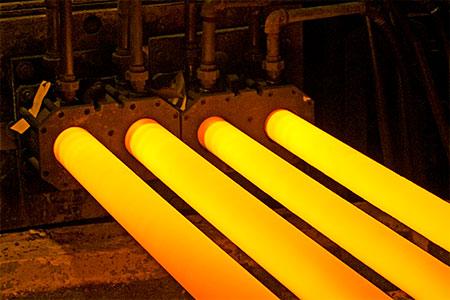Continuous Cast Process
In 1961, Wells Manufacturing Company introduced the process of continuous iron casting into North America. The process was originally developed in Europe after World War II as an alternate method of producing cast iron bar stock without patterns and conventional molding methods. Dura-Bar is still the only manufacturer of continuous cast iron bar stock in North America, and the largest producer in the world. In 2012, Charter Manufacturing Company acquired Wells Manufacturing Company and Dura-Bar.
A water-cooled graphite die that is machined to form the shape of the bar is mounted on a bar machine crucible. As the bar is pulled horizontally from the crucible, the ferrostatic head pressure feeds the molten iron core, producing a fine-grained cast iron.

The only part of the bar that is solidified when it exits the die is an outer skin; the core is molten iron. The entire bar cools in air until it is notched and broken off in standard lengths. The rim has a finer graphite structure in a matrix that is more ferritic than that in the center.
The most notable characteristic of continuous cast iron is its fine-grained, dense, as-cast microstructure. Since the bar is pulled from the bottom of the holding crucible, dross, slag and other impurities float to the top, away from the opening of the die.

Beginning with raw material selection, the entire Dura-Bar process is closely monitored to produce an engineered bar that will machine more consistently and at faster speeds than any other.